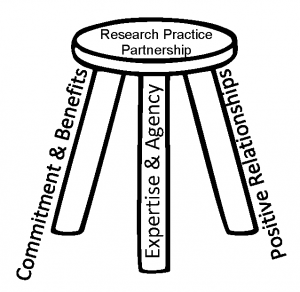Three-Legged Stool for a Successful Research-Practice Partnership
Dr. Joshua Wilson of the University of Delaware and Dr. Gaysha Beard of the Red Clay Consolidated School District discuss three critical factors to successful Research-Practice Partnerships.
We believe that the best way to bridge gaps between research and practice in education is for practitioners and researchers to collaboratively address issues of mutual concern and interest. Research-practice (R-P) partnerships are an increasingly prevalent and effective method of engaging in such collaboration. R-P partnerships are “long-term collaborations between practitioners and researchers that are organized to investigate problems of practice and solutions for improving schools and school districts”[i]
Our R-P partnership, which is currently supported by a federal grant from the Institute of Education Sciences, is now in its fourth year. It consists of a principal university partner, Dr. Joshua Wilson, an Assistant Professor at University of Delaware; his colleague, Dr. Charles MacArthur; and a principal district partner, Dr. Gaysha Beard, the Director of English Language Arts (ELA) K-12 for Red Clay Consolidated School District in Delaware. The goal of our partnership is to support the teaching and learning of writing in Red Clay. Currently, we are exploring ways that an automated essay evaluation system called PEG Writing may help achieve this goal.
 In hopes of offering insights that may benefit nascent or existing R-P partnerships, we thought we’d share our ideas on what makes for a successful R-P partnership, which we consider as arising from three mutually reinforcing elements: (1) Positive relationships, (2) Shared commitment and mutual benefit, and (3) Expertise and agency to address areas of need. These are mutually reinforcing because the strength of the whole rests on the stability of each of these elements. Just like a three-legged stool, if any one leg were to break or slip, the integrity of the whole structure would be jeopardized.
In hopes of offering insights that may benefit nascent or existing R-P partnerships, we thought we’d share our ideas on what makes for a successful R-P partnership, which we consider as arising from three mutually reinforcing elements: (1) Positive relationships, (2) Shared commitment and mutual benefit, and (3) Expertise and agency to address areas of need. These are mutually reinforcing because the strength of the whole rests on the stability of each of these elements. Just like a three-legged stool, if any one leg were to break or slip, the integrity of the whole structure would be jeopardized.
Positive Relationships
Education is ultimately about relationships: Relationships between teachers and students, between students and their peers, between teachers and principals, and between schools and the district and state that supports them, among other relationships. A successful partnership is no different. A long-term successful partnership requires positive relationships among the partners and all the constituents with whom the partners interact. In our partnership, positive relationships among the principal constituents (Wilson and Beard) are built on communication, kindness, respect, friendship, and whenever possible, business meetings outside the office over food! In addition, it’s important for our partnership that the teachers and students have a positive view of the university partners, and this is achieved by visiting schools, getting to know teachers and students on a first-name basis, responding to emails promptly, and doing everything possible to ensure that teachers and students feel supported by their university partners (see below for examples). This creates buy-in among the teachers and students to support the research-side of the partnership. It’s also critical that the university partners can rely on their district partner for leadership and support in implementing partnership activities.
Shared Commitment and Mutual Benefit
In addition to positive relationships, a successful R-P partnership rests on shared commitment and mutual benefit. On the district side, it’s critical that the university partners express a commitment that extends beyond the scope of a single project. This is quite different from the typical relationship between universities and districts in which university personnel approach a district seeking to gain access to its teachers and schools for a specific research project. In this model, the commitment has an expiration date that is concomitant with the end of the research project and the research focus is led by the university, not the district. Instead, a successful R-P partnership requires a greater investment on the side of the university partner, a shared commitment to the aims of the district to support its teachers and students, not just now, or for the next year, but in an ongoing fashion. We have been able to manifest this commitment by supporting the district’s changing needs, be it through providing professional development, on-site coaching and training, on-site tech support, and through supporting data collection and data analysis efforts. In essence, the commitment must be towards the goal – in our case supporting the teaching and learning of writing – and not just the immediate project activities that may support that goal.
From the university side, it’s critical that the district recognize the need for faculty to publish and disseminate their research. This means that it’s important for the university partner to feel confident that key research activities will be supported, such as obtaining district approval to conduct research, gaining permission to visit schools and teachers, embedding data collection mechanisms (e.g., surveys, assessments), and gaining access to district data. Once partners can trust in this shared commitment, it’s possible to derive significant mutual benefit. University partners get to conduct research that makes an impact locally and more broadly through dissemination efforts, and get to be connected to the real work of schools and teachers. Personally, I (Wilson) enjoy visiting schools and seeing students and being recognized as the PEG guy. It keeps me connected to my roots as a classroom teacher. District partners get to devote a level of focus, attention, and rigor to a problem of practice that is often difficult to address given the pace of day-to-day district decision making. In addition, district partners gain access to the unique expertise of university partners and get to participate in dissemination activities such as publishing and presenting at conferences.
Expertise and Agency to Address Areas of Need
As many district colleagues will tell you, so often districts are told everything that they’re doing wrong. Regularly, reports are written that identify problems, but rarely do these reports indicate feasible solutions that can be implemented within a district’s constraints. University partners need to be careful not to fall into this trap. It’s easy for university partners to cite current evidence-based practices and research that supports a certain solution, but completely overlook the challenges of implementation that prevents such a solution from being feasible. It’s important for university partners to recognize that it’s rarely the case that district partners are unaware of the ideal solution; it’s more often a feasibility issue. Therefore, it’s important for university personnel to listen and identify immediate, actionable steps that are feasible for a district to take. Thus, university partners must not only possess expertise to address the problem at hand, be it substantive knowledge about an issue (e.g., literacy, behavior), methodological knowledge, or knowledge of measurement and assessment, they must possess expertise in generating feasible solutions. At the same time, it’s critical that the district partner possess sufficient expertise to identify existing challenges and to understand how to take an idea and make it work in their district. Furthermore, the district partners need to be in a position to affect change; they need to be able to steer the ship towards a new course. This is no easy feat, as it often requires coordinating amongst colleagues in different departments (e.g., research office, data, curriculum, technology) and different roles (e.g., district and building administration, teachers)
In sum, we consider the three mutually reinforcing legs of a successful partnership to be positive relationships, shared commitment and mutual benefit, and expertise and agency to address areas of need. It’s important the R-P partners continually make investments in each of these three categories, so that as time passes the partnership grows continually stronger and more successful.
References
[i] Coburn, C. E., & Penuel, W. R. (2016). Research-practice partnerships in education: Outcomes, dynamics, and open questions. Educational Researcher, 45, 48-54.
The research reported here was supported by the Institute of Education Sciences, U.S. Department of Education, through Grant R305H170046 to the University of Delaware. The opinions expressed are those of the authors and do not represent views of the Institute or the U.S. Department of Education.
About the Authors:
Joshua Wilson, Ph.D., is an Assistant Professor in the School of Education at the University of Delaware. His research focuses on methods of assessing and instructing struggling writers, and on the application of automated essay scoring (AES) technology in Response to Intervention (RtI) contexts. He teaches courses at the University on elementary special education methods. He can be reached at joshwils@udel.edu.
Gaysha Beard, Ed.D., is the Director of English Language Arts (ELA) K-12 for Red Clay Consolidated School District in northern Delaware. She can be reached at gaysha.beard@redclay.k12.de.us.

Published by